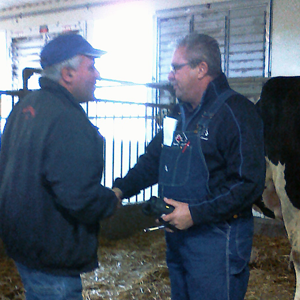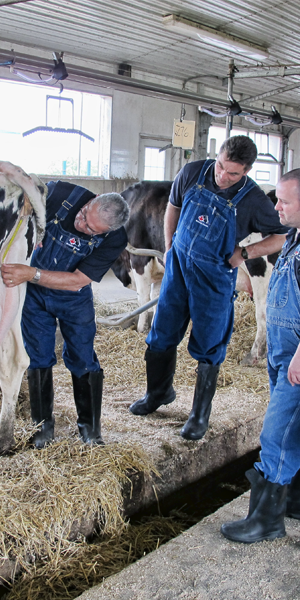There are many changes going on in the dairy industry these days. Producers must try to understand what programs are worth still participating in and what ones to drop. At the Bullvine we have had some producers ask, “Should I still classify my cows?” To that we say a resounding, “YES!” The following article explains why.
First, I would be remiss if I did not disclose that my father ran the Type Classification program here in Canada for 18 years, before it passed into the very capable hands of Jay Shannon and Tom Byers. I was raised understanding type classification and how the system works. From when Dad and the late Dalton Hodgins first started playing with the handheld units to when it was time to update the True Type Model, you could say that classification was bred into me. For me to even have to consider whether the program has merit is a very challenging situation. But when a breeder from California asked me the other day, “Why should I still type classify?” this caused me to stop and think about that, as I didn’t have an instant answer for him. So, in typical Bullvine fashion, I did some more thinking about it, a little bit of research and here is what I came up with.
Why Type Classify if you Genomic Test All Your Females?
Tom Byers said it best, in our interview a year ago. “Classification will be the conformation verification of our Genomic selected sires.” (Read more: Tom Byers – “That’s classified”). Genomics is not a perfect science and, in order to improve the accuracy of the genomic predictions, we need a larger data set. That means we need more daughters classified by these new genomic sires so that the geneticists can compare the genomic predictions of these sires to the actual performance of their daughters. Only then can the geneticists improve the formulations so their predictions become more accurate. Currently you can feel about 95% confident that a sire will come within 10% of their genomic prediction. With more information, that rate of confidence will increase while the range will decrease.
It’s also important to understand how these sires work in your herd. I cannot tell you the number of times I have seen some sires work wonders in some herds and totally fail in others. While the sire’s proof may average out over all herds, that does not mean he or his blood lines will work well in yours. That is why you still need programs like type classification and milk recording to validate that what you see on paper (genomic tests) is what you actually get in reality.
Why Classification is More Important than Ever When Marketing Your Cattle
It used to be that when a fresh 2 year old went Very Good many breeders wanted to see her picture to see if she really was a VG 2 year old. Often times it was felt that maybe that animal got a gift and maybe would have only been a GP84 in a different herd. Nowadays, with the state of dairy cattle photo ethics the way it is, I actually jump back to the classification to see if the picture really resembles the animal.
When I look at the picture and the heifer looks VG87+ but yet she is only classified VG85, I wonder why. Often I notice that animal may only be a 2 or 3 for loin strength, yet in her picture with all the “hair” added she looks closer to a 9. This causes a drastic change to the general appearance of the animal and greatly misrepresents her rump. That is why now, more than ever, I look at the full classification breakdown in order to get a better understanding of just what the animal looks like.
Another area I often notice is size and stature. With so many pictures having the original background removed and often the leadsperson as well, it is hard to get an accurate reference for the exact size of the animal. When the photographer or graphic designer is adding in the new background, they are doing so by what makes the animal look the best. While this is considered acceptable by today’s standards, it can greatly misrepresent the size and stature of the animal. (Read more: Has Photo Enhancement Gone Too Far?).
Another area where it is impossible to get an accurate read is heel depth and angularity. Because these animals are being cropped out of their original images, often they lose some of the depth of heal in the picture as well as their necks get accidentally cleaned up. While I do not think most photographers do so intentionally, the programs they are using combined with photographer’s Photoshop skills often cause some of these parts to be cropped, leaving a shallower foot and a cleaner head and neck. It is for these reasons we have recently started the Dairy Cattle Marketer’s Code of Ethics (Read more: Introducing The Dairy Marketing Code of Conduct) in order to help re-establish credibility in dairy cattle photographs.
The Bullvine Bottom Line
There is no question that the industry is changing at a very rapid rate. For some it`s not changing fast enough. For others, it seems too fast. While all programs need to evolve to meet the needs of the modern dairy producer, there is no question that a dynamic Type Classification program has its place. Since genomics is not a perfect science, and some dairy cattle photographs do not tell the full story, type classification remains the one constant for identifying the strengths and weaknesses of the individual, so that we can correctively mate to help the next generation function best in the different environments we ask her to work in. This combination of science and cow sense is what will lead us into a very prosperous future.
Get original “Bullvine” content sent straight to your email inbox for free.








 UDDERLY EXCELLENT
UDDERLY EXCELLENT FACING FORWARD WITH CLASSIFICATION
FACING FORWARD WITH CLASSIFICATION



